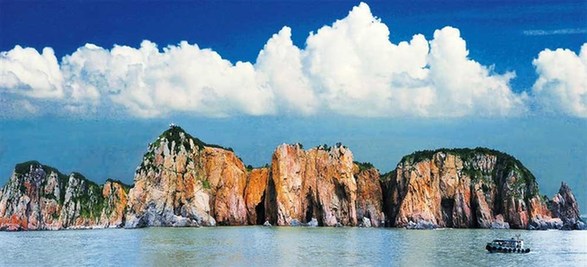Escape the city for sun, sand and seafood
 0 Comment(s)
0 Comment(s) Print
Print E-mail Shanghai Daily, August 22, 2017
E-mail Shanghai Daily, August 22, 2017
|
|
|
Dong’ao Village is an ideal respite for people who are looking for a short getaway from the scorching days. |
Zhejiang boasts a long coastline and more than 3,000 islands, endowing the place with a wealth of beauty from the sea.
To protect ocean resources and the environment, the government has imposed an annual seasonal moratorium on trawling and stake-net fishing.
This year, the moratorium is considered the strictest ever — from May 1 to September 16, one month longer than previous years.
There are strict regulations on the weight and size of fish.
During the moratorium, locals can only taste farmed seafood or frozen fish. But the ban is being lifted in batches from early August, and it will end completely after September 16.
After months of waiting, foodies can savor authentic wild seafood from the East China Sea.
The longer ban means shellfish will be much bigger than ever, luring gastronomes as soon as they hit the market.
But prices in Hangzhou’s wet markets are much more expensive than in the islands. Instead of sampling seafood at restaurants, many foodies choose to have a self-driving trip to the islands and buy direct from fishermen.
Experienced gastronomes recommend buying seafood in groups, since a whole bucket of fish is much cost-effective than a single fish. Meanwhile, people can wait on the wharf for the freshest and cheapest seafood from fishing boats as they come in.
In addition to seafood, some of the island towns and villages feature idyllic scenery, rich culture and homey guesthouses. Shanghai Daily takes a look at them and picks three that offer both picturesque views and yummy seafood.
Dongsha Town 东沙镇
The town is situated in Daishan County of the Zhoushan Archipelago, the nation’s largest fishing ground. Seafood caught there supplies markets all over China. Varieties include hairtail, yellow croaker, cuttlefish, sea eel, shrimp, crab and mussels.
The town’s history dates back an estimated 4,000 years when the first batch of people settled there and lived on fishing. In the Qin Dynasty (221-207 BC), Emperor Qin Shi Huang dispatched people to the eastern seas to find the elixir for eternal life. They landed in the town and left a rich history.
Today, the town still retains antique buildings erected in the Qing Dynasty (1644-1911). The black-tiled and white-wall houses reflect its glory days centuries ago. The town is also a fusion of religions, with Taoist, Buddhist and Confucian temples and churches, along with a mixture of different beliefs and traditions.
Throughout the year locals host a variety of events related to marine culture and fishing to celebrate the harvest.
As part of the area’s tourism development, a group of locals are now taking tourists out for what they call “happy fishing.”
Fishermen take tourists to catch fish, crab and shrimp. The tourists keep their catch and can take it to local restaurants to be cooked.
In addition to fresh seafood, Dongsha Town is also noteworthy for preserved seafood. A couple of time-honored brands in the town still use traditional methods.
Shipu Town 石浦镇
The town is in Ningbo. Its “half sea, half hill” landscape once attracted famous filmmaker Cai Chusheng, who used it as the backdrop of the classic movie “Song of the Fishermen.”
This 1930s classic ran for a record 84 days and made the town famous across the country.
Now, the town is renowned as a snapshot of traditional Chinese seafaring life. The buildings are mostly wood and stone, featuring traditional extended eaves and heavy wooden doors.
Locals live a traditional slow pace and the town has not been over-developed.
Fishing families sell seashell crafts on the street. Drying fish still hang on outdoor racks, flowers are planted in old conch shells and tempting seafood aromas waft from local kitchens.
Foodies can rent a boat, with all the equipment for fishing and netting. A three-and-a-half hour trip costs 200 yuan (US$30) per person. The size of the catch depends on your luck and skill.
Take it to any restaurant. Seafood can be cooked any way you like, and it only costs around 10 yuan per dish. Some restaurants will gladly buy any surplus catch. You can also take it home in an ice chest, if you’re driving.
Dong’ao Village 东岙村
The village belongs to Wenzhou, a city in the south of Zhejiang Province. Many people are looking for a short getaway from the scorching days and Dong’ao is an ideal respite.
The village draws tourists who flock there for beautiful island views, its cooler environment, sand and fresh seafood.
It offers a large variety of sea creatures, including fish, crabs, shrimp, hairtail, yellow croaker, cuttlefish, sea eel and mussels.
Wenzhou natives boast their own unique culinary traditions. Among the local delicacies, one of the must-try dishes is qiaoyu.
The fish are sliced into thin strips and coated with starch. These strips are then hammered into thin fillets and stewed with shredded ham, mushrooms and cabbage.
The yellow croaker, a local species, is often used as the main ingredient due to its delicate texture.







Go to Forum >>0 Comment(s)